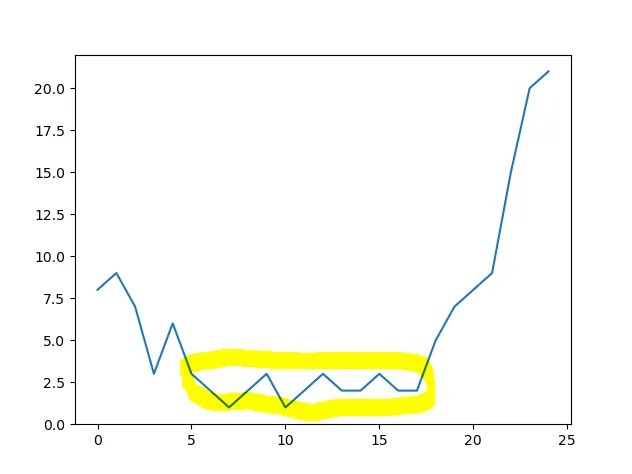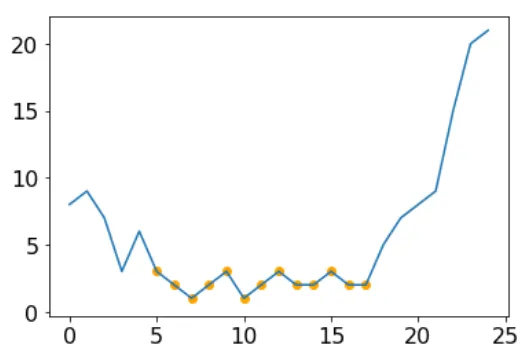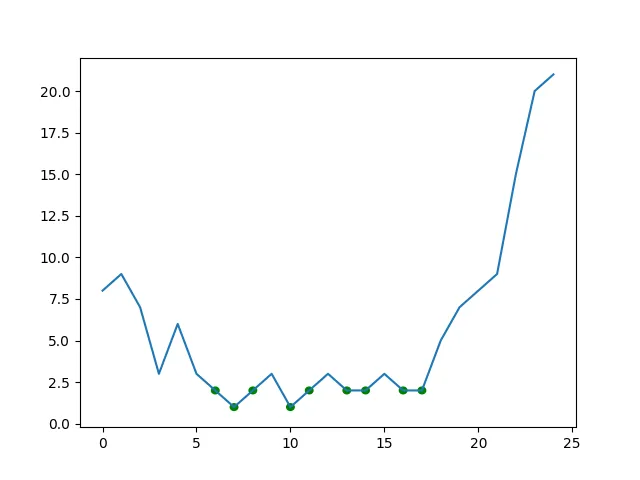如何识别嘈杂数据的较低周期的起点和终点?
7
- ManInMoon
8
定义“更少噪音”。 - mkrieger1
我的意思是该数字保持在高低范围的下限之内。 - ManInMoon
是的,您需要在程序中明确指定“lower”的含义 - 低于什么? - mkrieger1
这就是我一直在寻找答案的问题。我该如何定义这个区域。肉眼很明显。 - ManInMoon
你是在处理实时数据还是从数据库/CSV中收集的数据?这些数据是什么或者说它们的性质是什么? - EBDS
显示剩余3条评论
3个回答
4
你可以尝试通过测量噪声点周围值的方差来检测较少嘈杂的点。
例如,对于每个点,您可以查看其前面的最后N个值并计算它们的标准偏差,然后如果标准偏差低于某个阈值,就将该点标记出来。
以下代码使用pandas系列的
请注意,
例如,对于每个点,您可以查看其前面的最后N个值并计算它们的标准偏差,然后如果标准偏差低于某个阈值,就将该点标记出来。
以下代码使用pandas系列的
rolling方法应用此过程。std_thresh = 1
window_len = 5
s = pd.Series([8,9,7,3,6,3,2,1,2,3,1,2,3,2,2,3,2,2,5,7,8,9,15,20,21])
# Create a boolean mask which marks the less noisy points
marked = s.rolling(window=window_len).std() < std_thresh
# Whenever a new point is marked, mark also the other points of the window (see discussion below)
for i in range(window_len + 1, len(marked)):
if marked[i] and ~marked[i-1]:
marked[i - (window_len-1) : i] = True
plt.plot(s)
plt.scatter(s[marked].index, s[marked], c='orange')
window_len(计算标准差的窗口长度)和std_thresh(窗口标准差小于此值的点会被标记),并根据需要进行调整。请注意,
rolling考虑以每个点结尾的窗口,因此,当你遇到一个噪声较少的段时,它们中的前window_len-1个点将不会被标记。这就是为什么在定义marked后,我在代码中包含了for循环的原因。- Simone
1
对于给定的点,我们可以根据某些标准决定是否保留/屏蔽它:
- 其相邻点是否在某个范围内?
- 它是否在某个最小值的阈值范围内?
- 它是否处于连续的块中?
注:由于你标记并导入了 pandas,我将使用 pandas 进行方便,但是同样的想法也可以用纯 numpy/matplotlib 实现。
如果所有较低的周期大致相同
那么一个简单的方法是使用最小阈值的邻居差(但要注意实际数据中的异常值):
s = pd.Series(np.hstack([arr, arr]))
delta = 2
threshold = s.std()
# check if each point's neighbors are within `delta`
mask_delta = s.diff().abs().le(delta) & s.diff(-1).abs().le(delta)
# check if each point is within `threshold` of the minimum
mask_threshold = s < s.min() + threshold
s.plot(label='raw')
s.where(mask_threshold & mask_delta).plot(marker='*', label='delta & threshold')
如果较低的时期处于不同的级别
那么全局最小阈值将无法奏效,因为一些时期会太高。在这种情况下,请尝试使用带有连续块的相邻增量:
# shift the second period by 5
s = pd.Series(np.hstack([arr, arr + 5]))
delta = 2
blocksize = 10
# check if each point's neighbors are within `delta`
mask_delta = s.diff().abs().le(delta) & s.diff(-1).abs().le(delta)
# check if each point is in a contiguous block of at least `blocksize`
masked = s.where(mask_delta)
groups = masked.isnull().cumsum()
blocksizes = masked.groupby(groups).transform('count').mask(masked.isnull())
mask_contiguous = blocksizes >= blocksize
s.plot(label='raw')
s.where(mask_contiguous).plot(marker='*', label='delta & contiguous')
- tdy
0
嗯,如果你只是想要那个“区域”,你需要找到在特定范围内的点的方法。我们该怎么做呢?嗯,我们可能应该首先找到数组中的最小值,然后找出该数组中其他在指定偏差范围内的数值:
def lows(arr, dev=0):
lim = min(arr) + dev
pts = []
for i,e in enumerate(arr):
if e <= lim:
pts.append((i,e))
return pts
上述函数返回一个在指定范围内的点列表。下限是输入数组的最小值,上限是最小值加上您提供的偏差。例如,如果您想要所有低于最小值1的点:
plt.plot(arr)
for pt in lows(arr, 1):
circle = plt.Circle(pt, 0.2, color='g')
plt.gca().add_patch(circle)
plt.show()
- gmdev
网页内容由stack overflow 提供, 点击上面的可以查看英文原文,
原文链接
原文链接




